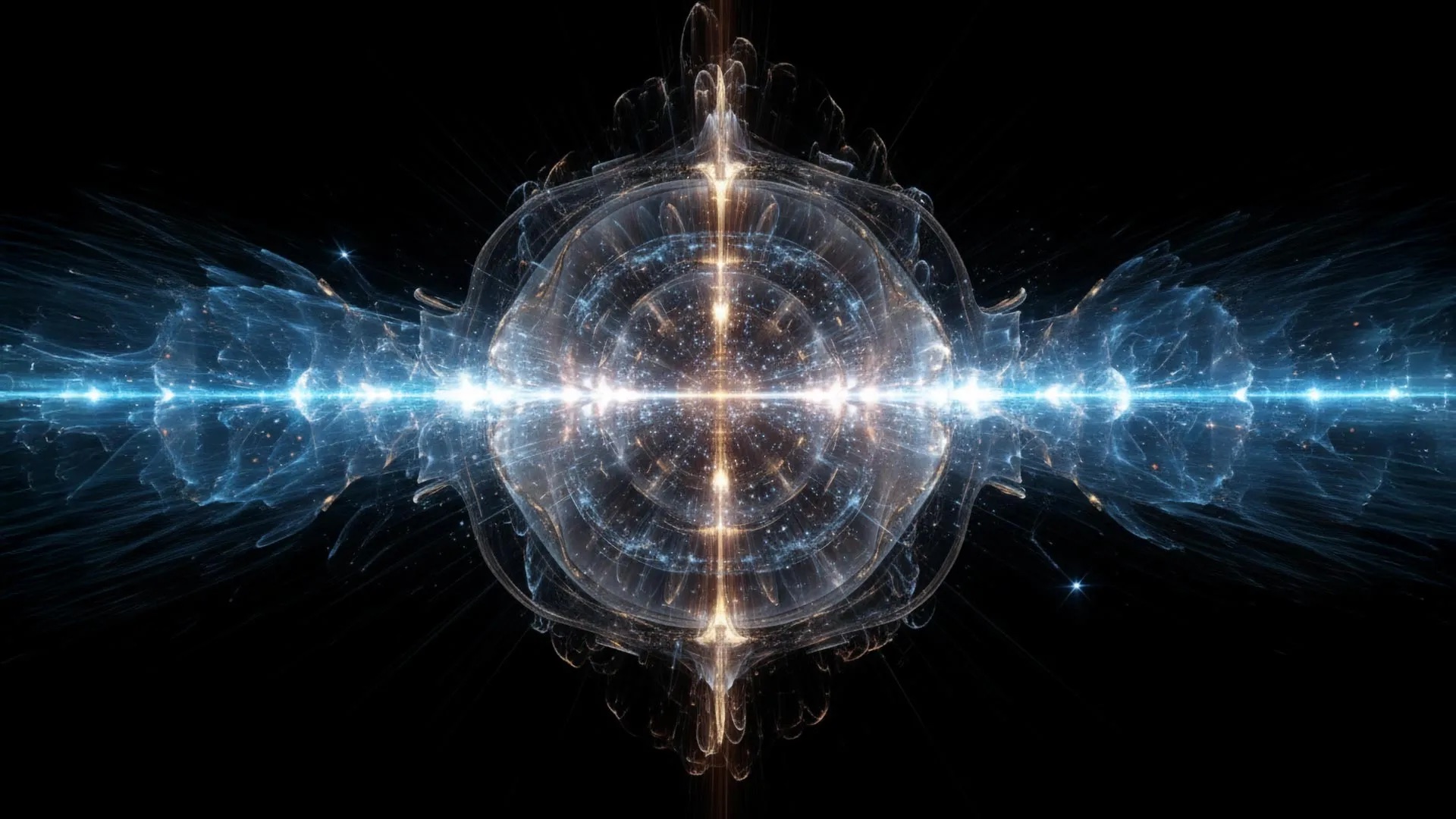
Physicists discover mysterious new type of time crystal Science Daily - October 15, 2025

Scientists reveal that quantum chaos can birth rhythmic order - time crystals that beat without a clock.
Imaginary numbers could be needed to describe reality, new studies find Live Science - December 21, 2021
Imaginary numbers are what you get when you take the square root of a negative number, and they have long been used in the most important equations of quantum mechanics, the branch of physics that describes the world of the very small. When you add imaginary numbers and real numbers, the two form complex numbers, which enable physicists to write out quantum equations in simple terms. But whether quantum theory needs these mathematical chimeras or just uses them as convenient shortcuts has long been controversial. In fact, even the founders of quantum mechanics themselves thought that the implications of having complex numbers in their equations was disquieting. In a letter to his friend Hendrik Lorentz, physicist Erwin Schrödinger - the first person to introduce complex numbers into quantum theory, with his quantum wave function ...
Physicists Confirm The Existence of Time Crystals in Epic Quantum Computer Simulation Science Alert - December 1, 2021
Researchers used Google's Sycamore quantum computing hardware to double-check their theoretical vision of a time crystal, confirming it ticks all of the right boxes for an emerging form of technology we're still getting our head around.
A major milestone in particle physics has just been made at the Large Hadron Collider (LHC). For the first time, candidate neutrinos have been detected, not just at the LHC, but in any particle collider Science Alert - November 29, 2021
The six neutrino interactions, detected using the neutrino subdetector FASERnu, not only demonstrate the feasibility of the technology, they open up a new avenue for studying these mysterious particles, particularly at high energies.
What Happens if 4 Electrons Join Up? A Brand New State of Matter Says a Recent Study Science Alert - October 23, 2021
Almost 20 years after researchers first predicted electron quadruplets, evidence of their existence has been shown to occur in experimental setups, representing a brand new state of matter that opens up a whole new field of possibilities in physics.
Physicists give weird new phase of matter an extra dimension. The supersolid's atoms can move without ever losing energy Live Science - August 18, 2021
Physicists have created the first ever two-dimensional supersolid - a bizarre phase of matter that behaves like both a solid and a frictionless liquid at the same time. Supersolids are materials whose atoms are arranged into a regular, repeating, crystal structure, yet are also able to flow forever without ever losing any kinetic energy. Despite their freakish properties, which appear to violate many of the known laws of physics, physicists have long predicted them theoretically - they first appeared as a suggestion in the work of the physicist Eugene Gross as early as 1957.
US lab stands on threshold of key nuclear fusion goal BBC - August 18, 2021
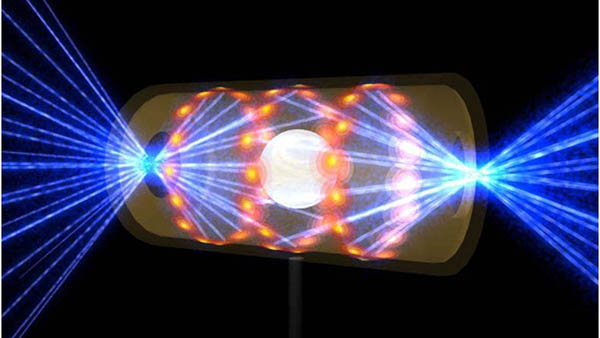
An experiment suggests the goal of "ignition", where the energy released by fusion exceeds that delivered by the laser, is now within touching distance. Harnessing fusion, the process that powers the Sun, could provide a limitless, clean energy source. In a process called inertial confinement fusion, 192 beams from NIF's laser - the highest-energy example in the world - are directed towards a peppercorn-sized capsule containing deuterium and tritium, which are different forms of the element hydrogen.
Physicists in California Achieve 'Historic' Nuclear Fusion Breakthrough Science Alert - August 18, 2021
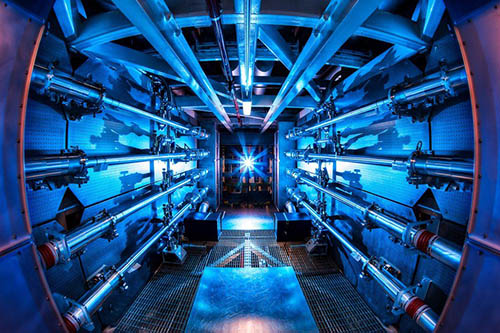 Nuclear scientists using lasers the size of three football fields said Tuesday they had generated a huge amount of energy from fusion, possibly offering hope for the development of a new clean energy source.
Nuclear scientists using lasers the size of three football fields said Tuesday they had generated a huge amount of energy from fusion, possibly offering hope for the development of a new clean energy source.
What God, quantum mechanics and consciousness have in common Live Science - August 17, 2021
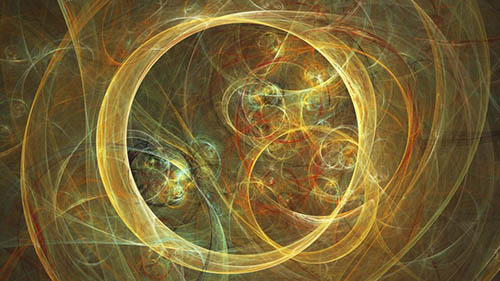
Why do we exist? The answer, according to the major monotheistic religions, including the Catholic faith in which I was raised, is that an all-powerful, supernatural entity created us. This deity loves us, as a human father loves his children, and wants us to behave in a certain way. If we're good, He'll reward us. If we're bad, He'll punish us. (I use the pronoun "He" because most scriptures describe God as male.)
Famous Einstein equation used to create matter from light for first time Live Science - August 16, 2021
Two colliding light particles were used to create a matter-antimatter pairIn a stunning demonstration of one of Einstein's most famous equations, physicists are claiming to have created matter from pure light for the very first time. Albert Einstein's famous E=mc2 equation says that if you smash two sufficiently energetic photons, or light particles, into each other, you should be able to create matter in the form of an electron and its antimatter opposite, a positron.
Rare 'Alien' Isotopes in Earth's Crust Point to Recent Brush With a Cataclysmic Event Science Alert - May 15, 2021
Far down in the periodic table you'll find a list of heavy elements born in chaos. The kind of chaos you might find in an exploding star perhaps, or a collision between two neutron stars.
Extraterrestrial Plutonium Atoms Turn Up on Ocean Bottom - The rare form of the element found on the Pacific seabed points to its violent birth in colliding stars Live Science - May 13, 2021
The plutonium-244 hints at how heavy metals form in stars. A rare version of the radioactive element plutonium embedded in Earth's crust below the deep sea is providing new clues as to how heavy metals form in the stars. The new research finds that the isotope, called plutonium-244, may arrive on Earth in tandem with iron-60, a lighter metal known to form in supernovas, explosions that occur during the death throes of many types of stars. This finding suggests that supernovas may create both heavy metals - although it's possible that other events, such as the mergers of neutron stars, are responsible for at least some of the plutonium-244. Understanding how heavy elements formed is one of the top three most burning questions in physics. Half of elements heavier than iron are built in the hearts of stars through a fairly well-understood process of fusion. The other half, though, requires a high density of free neutrons to form. This means they must form in a more explosive environment than a typical star core - supernovas, perhaps, or massive events such as a neutron-star merger or a collision of a black hole and a neutron star.
Testing Our Fundamental Understanding of the Universe: Muon G-2 Experiment Hints at Mysterious New Physics SciTechDaily - April 8, 2021
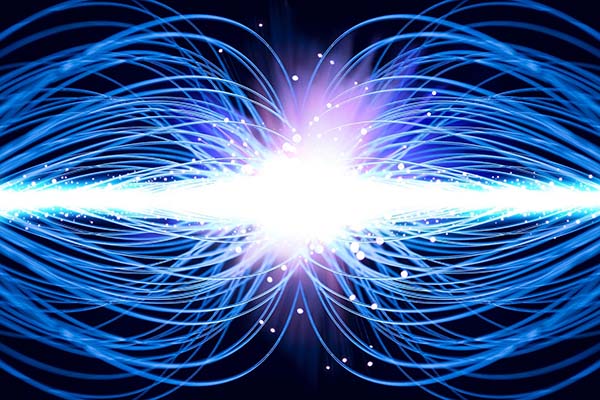
Scientists from the U.S. Department of Energy's (DOE) Argonne National Laboratory and Fermi National Accelerator Laboratory, along with collaborators from 46 other institutions and seven countries, are conducting an experiment to put our current understanding of the universe to the test. The first result points to the existence of undiscovered particles or forces. This new physics could help explain long-standing scientific mysteries, and the new insight adds to a storehouse of information that scientists can tap into when modeling our universe and developing new technologies
Muons: 'Strong' evidence found for a new force of nature BBC - April 7, 2021
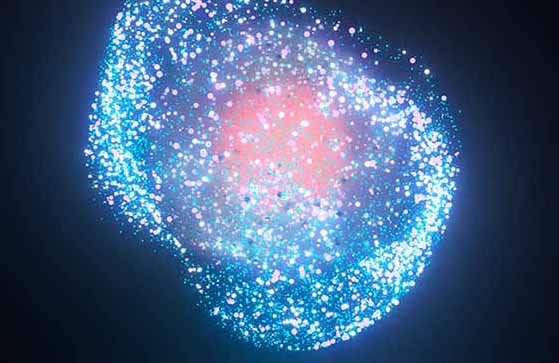
Muons are subatomic particles. This tiny particle appears to disobey the laws of physics, challenging scientists' understanding of the universe. Evidence is mounting that muons are disobeying the known laws of physics a finding that would open a vast and tantalizing hole in our understanding of the universe. The result, physicists say, suggests that there are forms of matter and energy vital to the nature and evolution of the cosmos that are not yet known to science. The Muon g-2 ring, at the Fermi National Accelerator Laboratory in Batavia, Ill., operates at minus 450 degrees Fahrenheit and studies the wobble of muons as they travel through the magnetic field.
Scientists Have Discovered a New Pattern In a Repeating Signal from Space - What astronomers found in the most precise time measurement of a fast radio burst ever captured Vice - March 24, 2021
or more than a decade, scientists have been working to unravel the mysteries of so-called fast radio bursts (FRBs), which are sudden and unexplained radio pulses that are mostly observed in distant galaxies. These bizarre bursts, which last for mere milliseconds and sometimes repeat in odd patterns, have inspired explanations ranging from pyrotechnic interactions between exotic stars to signs of extraterrestrial intelligence. Now, astronomers have managed to probe a repeating burst at the shortest timescales ever, meaning that a team studied its signature at tiny periods of just 3 to 4 microseconds within those millisecond pulses. This unprecedented analysis revealed a newly observed microstructure, or a pattern of variable brightness, revealing that the new technique can unveil clues into [FRB] emission physics.
Engineers Have Proposed The First Model For a Physically Possible Warp Drive
Now a group of physicists have put together the first proposal for a physical warp drive, based on a concept devised back in the '90s. And they say it shouldn't break any of laws of physics. Theoretically speaking, warp drives bend and change the shape of space-time to exaggerate differences in time and distance that, under some circumstances, could see travelers move across distances faster than the speed of light.
Meet the swirlon, a new kind of matter that bends the laws of physics Live Science - March 5, 2021
Fish school, insects swarm and birds fly in murmurations. Now, new research finds that on the most basic level, this kind of group behavior forms a new kind of active matter, called a swirlonic state.
Physicists trap ultracold plasma in a magnetic bottle for the 1st time Live Science - March 4, 2021
Capturing lightning in a bottle is the very definition of a tough task, but now physicists have found a way to contain ultracold plasma in a magnetic bottle trap, a breakthrough that could bring physicists one step closer to understanding solar winds and achieving nuclear fusion.
Plasma is one of the four states of matter, consisting of positive ions and negative free electrons. But unlike solids, liquids and gases, its tendency to occur in only the most extreme places, such as in the streak of ionized air we call a lightning bolt, in the dancing pattern of the aurora borealis, or on the surface of the sun, makes it extremely difficult to study. This difficulty is only worsened by the fact that the plasmas in the Northern Lights or on the sun's surface interact with a complex magnetic field in ways scientists have yet to fully understand.
Physicists Just Found 4 New Subatomic Particles That May Test The Laws of Nature Science Alert - March 5, 2021
This month is a time to celebrate. CERN has just announced the discovery of four brand new particles at the Large Hadron Collider (LHC) in Geneva. This means that the LHC has now found a total of 59 new particles, in addition to the Nobel prize-winning Higgs boson, since it started colliding protons – particles that make up the atomic nucleus along with neutrons - in 2009.
World's first video of a space-time crystal PhysOrg - February 24, 2021
A German-Polish research team has succeeded in creating a micrometer-sized space-time crystal consisting of magnons at room temperature. A crystal is a solid whose atoms or molecules are regularly arranged in a particular structure. If one looks at the arrangement with a microscope, one discovers an atom or a molecule always at the same intervals. It is similar with space-time crystals: however, the recurring structure exists not only in space, but also in time. The smallest components are constantly in motion until, after a certain period, they arrange again into the original pattern.
Decades-Long Experiment Finds Strange Mix of Antimatter in The Heart of Every Proton Science Alert - February 26, 2021
As convenient as this simple metaphor might be, the quantum engine operating within these subatomic particles is an incomprehensible ledger of quantum economics: quarks and antiquarks adding up and cancelling out, but never balancing.
CSI Solid-State: The fingerprints of quantum effects PhysOrg - February 19, 2021

n solid-state physics, the precise interactions of electrons are analyzed through meticulous detective work, ultimately to gain a better understanding of fundamental physical phenomena. It comes as no surprise to fans of the thriller genre that in order to solve a case, fingerprints must be carefully located at the crime scene. In modern-day solid-state physics, scientists look for scattering processes - interactions between electrons - that hold the clues necessary for getting closer to the truth.
Physicists Observe Fleeting 'Polaron' Quasiparticles For The First Time Science Alert - January 19, 2021
Polarons are important nanoscale phenomena: a transient configuration between electrons and atoms (known as quasiparticles) that exist for only trillionths of a second. These configurations have unique characteristics that can help us understand some of the mysterious behaviors of the materials they form within – and scientists have just observed them for the first time.
For The First Time, a New State of Matter Has Been Observed in a Thread of Quantum Gas Science Alert - January 15, 2021
Physicists have observed a new state of matter at work inside an elusive thread of quantum gas. The gossamer-thin strings of gas capable of binding giants sound like items worthy of a quest in Grimms' fairy tales. But versions of these materials are theoretically possible in physics - unfortunately though, in practice they inevitably collapse on forming.
Physicists Detect Tantalizing Hints of a "Fundamentally New Form of Quantum Matter" Science Alert - January 13, 2021
The team looked at tungsten ditelluride, which is a strange semimetal that takes on properties of an insulator when bathed in a magnetic field - and were surprised to see quantum oscillations happening. Despite the shock, they have some thoughts on what could be going on. While a flowing charge would make this insulator a conductor (which is a paradox), having neutral particles 'flow' would fit the bill of insulator and quantum oscillator, which makes more sense.
New evidence that the quantum world is even stranger than we thought PhysOrg - September 5, 2020
New experimental evidence of a collective behavior of electrons to form "quasiparticles" called "anyons". Anyons have characteristics not seen in other subatomic particles, including exhibiting fractional charge and fractional statistics that maintain a "memory" of their interactions with other quasiparticles by inducing quantum mechanical phase changes.
LHC creates matter from light PhysOrg - September 4, 2020
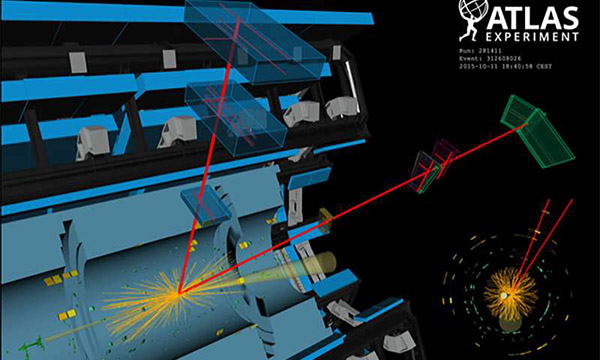
The Large Hadron Collider plays with Albert Einstein's famous equation, E = mc2, to transform matter into energy and then back into different forms of matter. But on rare occasions, it can skip the first step and collide pure energy - in the form of electromagnetic waves. Last year, the ATLAS experiment at the LHC observed two photons, particles of light, ricocheting off one another and producing two new photons. This year, they've taken that research a step further and discovered photons merging and transforming into something even more interesting: W bosons, particles that carry the weak force, which governs nuclear decay. This research doesn't just illustrate the central concept governing processes inside the LHC: that energy and matter are two sides of the same coin. It also confirms that at high enough energies, forces that seem separate in our everyday lives - electromagnetism and the weak force - are united.
For The First Time, Physicists Have Controlled The Interaction of Time Crystals Science Alert - August 17, 2020

The existence of time crystals - a particularly fascinating state of matter - was only confirmed a few short years ago, but physicists have already made a pretty major breakthrough: they have induced and observed an interaction between two time crystals. Time crystals are pretty fascinating. They look just like normal crystals, but they sport an additional, peculiar property.
The Mysterious 'Blue Whirl' Flame Is Actually 3 Different Flames Combined Science Alert - August 15, 2020
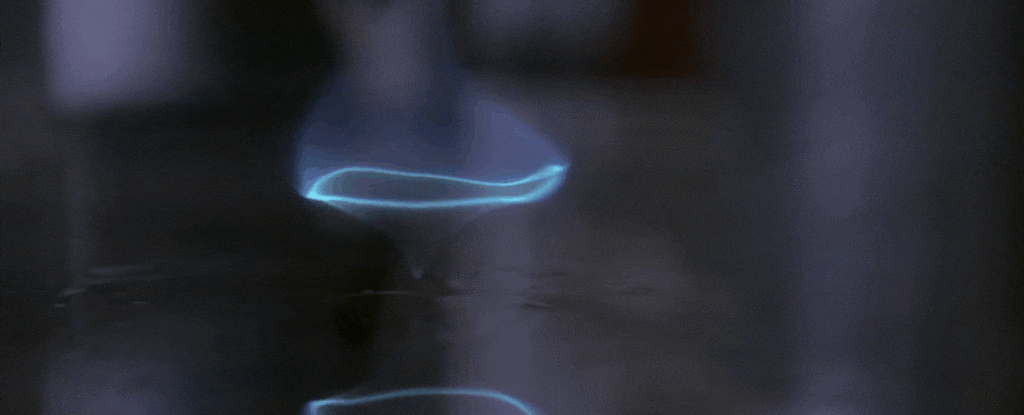
For hundreds of thousands of years, humans have cultivated a close relationship with fire. But for all our fascination and intimacy, both with its dangers and its uses, fire can still stun us with something we've never seen before. The blue whirl flame was discovered quite by accident just a few years ago. Scientists were studying a particularly dangerous type of flame - the whirls that, in wildfires, turn into terrifying fire tornadoes that wreak disaster, but that could be harnessed to generate power, or clean oil spills.
But from their sooty flames emerged something new - a clean, dancing, pure blue twist of fire. Now, scientists have used simulations to reproduce the eerily beautiful flame - and through doing so, have finally come to understand its structure.
The universe's clock might have bigger ticks than we imagine Live Science - July 13, 2020
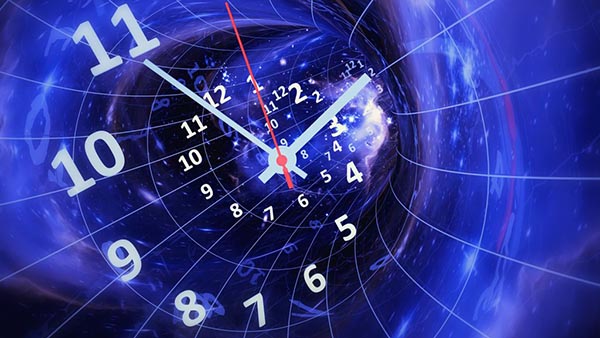
The smallest conceivable length of time might be no larger than a millionth of a billionth of a billionth of a billionth of a second. That's according to a new theory describing the implications of the universe having a fundamental clock-like property whose ticks would interact with our best atomic timepieces. Such an idea could help scientists get closer to doing experiments that would illuminate a theory of everything, an overarching framework that would reconcile the two pillars of 20th-century physics - quantum mechanics, which looks at the smallest objects in existence, and Albert Einstein's relativity, which describes the most massive ones.
Physicists Have Finally Detected 'Missing' Neutrinos Generated Deep Within Our Sun Science Daily - June 26, 2020
Every second, trillions upon trillions of incredibly low-mass subatomic particles called neutrinos shoot out from the Sun and slide undetected through your body. These neutrinos are produced by the two known types of fusion reactions that happen in our Sun, and up until now scientists have only detected one group of them - the neutrinos produced by protons squeezing together to create helium.
Exploring new ways to see the Higgs Boson PhysOrg - June 4, 2020
The ATLAS and CMS collaborations presented their latest results on new signatures for detecting the Higgs boson at CERN's Large Hadron Collider. These include searches for rare transformations of the Higgs boson into a Z boson - which is a carrier of one of the fundamental forces of nature - and a second particle. Observing and studying transformations that are predicted to be rare helps advance our understanding of particle physics and could also point the way to new physics if observations differ from the predictions. The results also included searches for signs of Higgs transformations into "invisible" particles, which could shine light on potential dark-matter particles. The analyses involved nearly 140 inverse femtobarns of data, or around 10 million billion proton–proton collisions, recorded between 2015 and 2018.
Mysterious particles spewing from Antarctica defy physics Live Science - January 24, 2020
Our best model of particle physics is bursting at the seams as it struggles to contain all the weirdness in the universe. Now, it seems more likely than ever that it might pop, thanks to a series of strange events in Antarctica. The death of this reigning physics paradigm, the Standard Model, has been predicted for decades. There are hints of its problems in the physics we already have. Strange results from laboratory experiments suggest flickers of ghostly new species of neutrinos beyond the three described in the Standard Model. And the universe seems full of dark matter that no particle in the Standard Model can explain.
Do We Live in a Quantum World? Physicists are still trying to reconcile two different worlds: the quantum and the macro Live Science - December 1, 2019
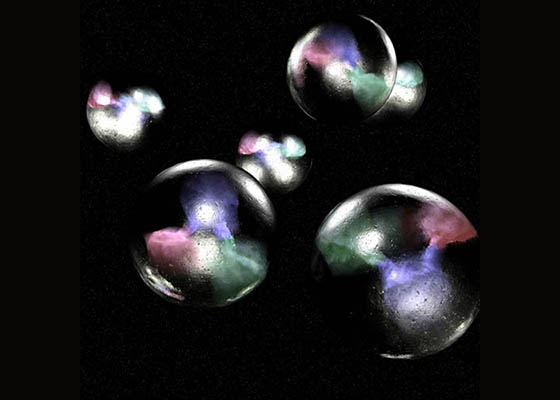
Let's face it: quantum mechanics is really confusing. All the rules of physics that we're used to simply go straight out the window in the quantum realm. Put a particle in a box. According to classical physics (and common sense), that particle should stay in that box forever. But under quantum mechanics, that particle can simply be outside the box the next time you look. In classical thinking, you can measure the momentum and position of something to an arbitrary degree of precision. Not so in the quantum world - the more you know about one, the less you know about the other. Is something a wave or a particle? According to the classical viewpoint, you can pick one and only one. But ask your friendly neighborhood quantum mechanic, and they'll tell you something can be both.
The weirdest idea in quantum physics is catching on: There may be endless worlds with countless versions of you. NBC - October 22, 2019
According to an increasingly popular analysis of quantum mechanics known as the many worlds interpretation. every fundamental event that has multiple possible outcomes whether it’s a particle of light hitting Mars or a molecule in the flame bouncing off your teapot - splits the world into alternate realities. Even if you never meet those other you's, some physicists say they're out there.
2,000 Atoms Exist in Two Places at Once in Unprecedented Quantum Experiment PhysOrg - October 4, 2019
The new experiment demonstrated a bizarre quantum effect from the double-slit experiment at an unprecedented scale. Giant molecules can be in two places at once, thanks to quantum physics. That's something that scientists have long known is theoretically true based on a few facts: Every particle or group of particles in the universe is also a wave - even large particles, even bacteria, even human beings, even planets and stars. And waves occupy multiple places in space at once. So any chunk of matter can also occupy two places at once. Physicists call this phenomenon "quantum superposition," and for decades, they have demonstrated it using small particles
A Strange New Higgs Particle May Have Stolen the Antimatter from Our Universe Space.com - September 29, 2019
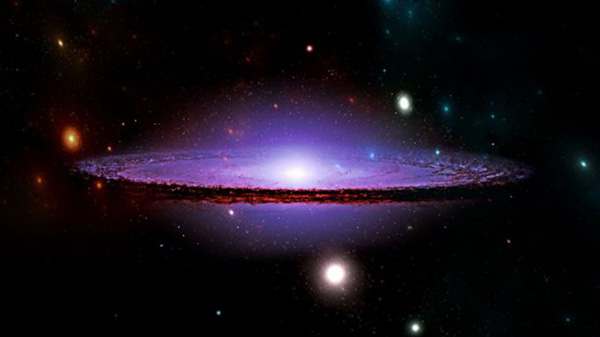
Why our universe is swirling with more matter than its bizarre counterpart antimatter is one of the most perplexing puzzles of modern physics. Somehow, when the universe was incredibly young, almost all the antimatter disappeared, leaving just the normal stuff. Theorists have long stalked the ever-elusive explanation - and more important, a way to test that explanation with experiments. Now, a trio of theorists has proposed that a trio of particles called Higgs bosons could be responsible for the mysterious vanishing act of antimatter in the universe. And they think they know how to find the suspected culprits.
Fermilab achieves world-record field strength for accelerator magnet PhysOrg - September 9, 2019
To build the next generation of powerful proton accelerators, scientists need the strongest magnets possible to steer particles close to the speed of light around a ring. For a given ring size, the higher the beam's energy, the stronger the accelerator's magnets need to be to keep the beam on course.
Physicists mash quantum and gravity and find time, but not as we know it Science Daily - August 27, 2019
Researchers say they have discovered 'a new kind of quantum time order'. The discovery arose from an experiment the team designed to bring together elements of the two big -- but contradictory -- physics theories developed in the past century.
Physicists Just Released Step-by-Step Instructions for Building a Wormhole Live Science - August 27, 2019
All you need are a couple of black holes and a few infinitely long cosmic strings.
Scientists unveil the first-ever image of quantum entanglement PhysOrg - July 14, 2019
For the first time ever, physicists have managed to take a photo of a strong form of quantum entanglement called Bell entanglement - capturing visual evidence of an elusive phenomenon which a baffled Albert Einstein once called 'spooky action at a distance'.
New property of light discovered - self-torque PhysOrg - June 28, 2019
More recently, researchers have found that light can also be twisted, a property called angular momentum. Beams with highly structured angular momentum are said to have orbital angular momentum (OAM), and are called vortex beams. They appear as a helix surrounding a common center, and when they strike a flat surface, they appear as doughnut-shaped. In this new effort, the researchers were working with OAM beams when they found the light behaving in a way that had never been seen before.
Machine learning unlocks mysteries of quantum physics PhysOrg - June 20, 2019
Understanding electrons' intricate behavior has led to discoveries that transformed society, such as the revolution in computing made possible by the invention of the transistor.Today, through advances in technology, electron behavior can be studied much more deeply than in the past, potentially enabling scientific breakthroughs as world-changing as the personal computer. However, the data these tools generate are too complex for humans to interpret.
Breaks in the Perfect Symmetry of the Universe Could Be a Window Into Completely New Physics Live Science - June 14, 2019
The bible of particle physics is dying for an upgrade. And physicists may have just the thing: Some particles and forces might look in the mirror and not recognize themselves. That, in itself, would send the so-called Standard Model into a tailspin. Just about all fundamental reactions between the universe’s subatomic particles look the same when they are flipped around in a mirror. The mirror-image, called parity, is then said to be symmetrical, or to have parity symmetry, in physics speak. Of course, not everyone follows the rules. We know that, for instance, reactions involving the weak nuclear force, which is also weird for a whole bunch of other reasons, violates parity symmetry. So it stands to reason other forces and particles in the quantum world are also rule-breakers in this area.
Physicists Search for Monstrous Higgs Particle. It Could Seal the Fate of the Universe Live Science - June 5, 2019
We all know and love the Higgs boson - which to physicists' chagrin has been mistakenly tagged in the media as the "God particle" - a subatomic particle first spotted in the Large Hadron Collider (LHC) back in 2012. That particle is a piece of a field that permeates all of space-time; it interacts with many particles, like electrons and quarks, providing those particles with mass, which is pretty cool.
But the Higgs that we spotted was surprisingly lightweight. According to our best estimates, it should have been a lot heavier. This opens up an interesting question: Sure, we spotted a Higgs boson, but was that the only Higgs boson? Are there more floating around out there doing their own things? Though we don't have any evidence yet of a heavier Higgs, a team of researchers based at the LHC, the world's largest atom smasher, is digging into that question as we speak. And there's talk that as protons are smashed together inside the ring-shaped collider, hefty Higgs and even Higgs particles made up of various types of Higgs could come out of hiding.
Inside Giant Atom Smasher, Physicists See the Impossible: Light Interacting with Light Live Science - April 25, 2019
n case you didn't realize it, photons are tiny little bits of light. In fact, they're the smallest bit of light possible. When you turn on a lamp, gigantic numbers of photons spring from that bulb and slam into your eyes, where they are absorbed by your retina and turned into an electrical signal so that you can see what you are doing. So, you can imagine just how many photons surround you at any one time. Not just from the lights in your room, but photons also stream in through the window from the sun. Even your own body generates photons, but all the way down in infrared energies, so you need night vision goggles to see them. But they're still there. And, of course, all the radio waves and ultraviolet rays and all the other rays constantly bombard you and everything else with an endless stream of photons.
Cosmic 'superbubbles' that act like particle accelerators 100 times more powerful than the Large Hadron Collider are discovered in a galaxy 67 million light years from Earth Daily Mail - March 6, 2019
The superbubbles, shown in purple, emit so much energy and are so hot they emit X-rays. The 'extremely energetic cosmic rays' that are generated in their formation have been detected and captured by a combination of radio, X-ray, and optical imaging from NASA. The X-rays were picked up by NASA's Chandra X-ray observatory, and together with optical data from the NASA's Hubble Telescope, the space agency was able to create both wide field and close-up images of the phenomena. According to NASA, the bubbles, which are shown in purple in images, are located in the spiral galaxy known as NGC 3079 which is 50 million light-years away from Earth. The bigger of the two bubbles spans 4,900 light years in diameter and the smaller is 3,600 light years across.
Physicists Found a Brand-New Kind of Magnet Hiding in a Uranium Compound Live Science - February 9, 2019
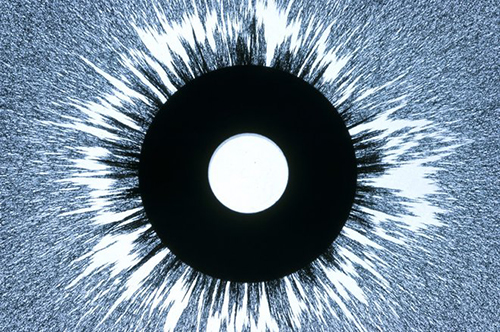
Scientists have discovered a brand-new kind of magnet hiding out in a uranium compound. The compound, USb2 (a compound of uranium and antimony), a so-called "singlet-based" magnet, is novel in that it generates magnetism in an entirely different way than any other magnet known to scientists. Electrons, which are negatively charged particles, generate their own tiny magnetic fields. These fields have a "north" and "south" pole, a consequence of a quantum mechanical property known as spin. In most objects, these magnetic fields point in random directions, canceling each other out. (This is why your body isn't a giant magnet.) But in certain materials, those fields become aligned. When that happens, they create a magnetic field powerful enough to, for example, move a bunch of iron filing around or cause a compass to point north.
Physicists puzzled by strange numbers that could explain reality - Physicists discover complex numbers called octonions that work in 8 dimensions Big Think - January 10, 2019
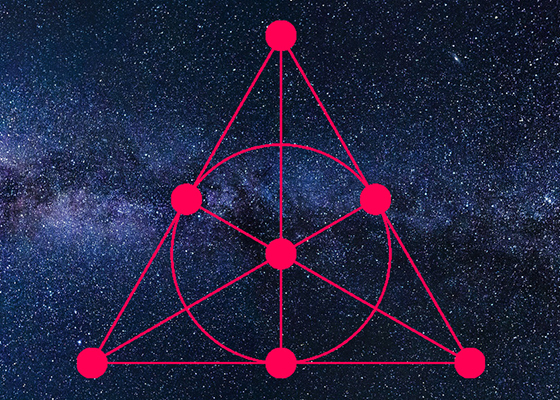
Understanding octonions can lead to a new model of physics. Is our reality, including its forces and particles, based on the strange properties of numbers with eight dimensions called "octonions"? A physicist thinks so, having found a way to expand 40-year-old research to reach surprising new directions.
Einstein's Theory of General Relativity Just Survived a Massive Crash in Outer Space Live Science - November 29, 2018
The researchers in the new study also analyzed gravitational waves to see whether the graviton - the theoretical particle that carries gravity - might have mass, like other particles do. If there was such a thing as a "massive graviton," gravitational waves would also have mass, and if these waves had mass, they would exhibit signs of momentum, unlike light particles, which are massless. That would also be a violation of general relativity. But, again, it didn't happen. Overall, researchers found, Einstein's theories of gravity remain basically intact. Someday, that might change. But it hasn't yet, even after two neutron stars slammed into each other.
Physics: Not everything is where it seems to be PhysOrg - October 17, 2018
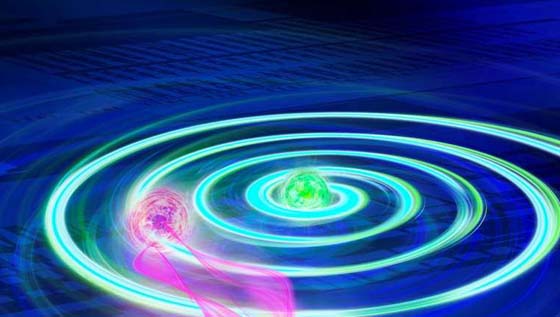
Scientists have for the first time demonstrated a wave effect that can lead to measurement errors in the optical position estimation of objects. The work could have consequences for optical microscopy and optical astronomy, but could also play a role in position measurements using sound, radar, or gravitational waves.
Study supports Standard Model of particle physics, excludes alternative models PhysOrg - October 17, 2018
In a new study, researchers at Northwestern, Harvard and Yale universities examined the shape of an electron's charge with unprecedented precision to confirm that it is perfectly spherical. A slightly squashed charge could have indicated unknown, hard-to-detect heavy particles in the electron's presence, a discovery that could have upended the global physics community.
Stephen Hawking's final book reveals his answers to the big questions Daily Mail - October 15, 2018
1. There is no God. No one directs the universe.
2. There are forms of intelligent life out there. Be careful.
3. Travel back in time can't be ruled out
Rise of the super-rich master race: Stephen Hawking's last essay predicted a new race of 'superhumans' that could destroy the rest of humanity after wealthy people start manipulating their children's DNA Medical Express - October 15, 2018
Stephen Hawking warned about the dangers of manipulating DNA in a series of articles and essays.
Surprising hidden order unites prime numbers and crystal-like materials PhysOrg - September 6, 2018
The seemingly random digits known as prime numbers are not nearly as scattershot as previously thought. A new analysis by Princeton University researchers has uncovered patterns in primes that are similar to those found in the positions of atoms inside certain crystal-like materials.
Long-sought decay of Higgs boson observed PhysOrg - August 28, 2018
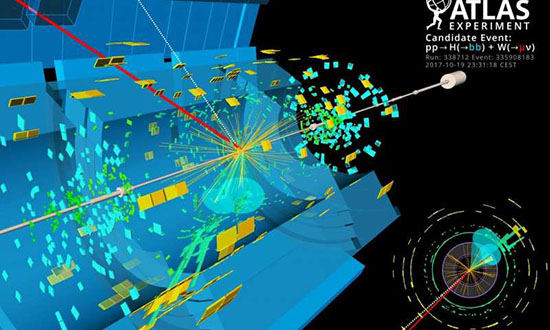
Six years after its discovery, the Higgs boson has at last been observed decaying to fundamental particles known as bottom quarks. The finding, presented today at CERN1 by the ATLAS and CMS collaborations at the Large Hadron Collider (LHC), is consistent with the hypothesis that the all-pervading quantum field behind the Higgs boson also gives mass to the bottom quark. Both teams have submitted their results for publication today. The Standard Model of particle physics predicts that about 60% of the time a Higgs boson will decay to a pair of bottom quarks, the second-heaviest of the six flavors of quarks. Testing this prediction is crucial because the result would either lend support to the Standard Model – which is built upon the idea that the Higgs field endows quarks and other fundamental particles with mass – or rock its foundations and point to new physics. Spotting this common Higgs-boson decay channel is anything but easy, as the six-year period since the discovery of the boson has shown. The reason for the difficulty is that there are many other ways of producing bottom quarks in proton–proton collisions. This makes it hard to isolate the Higgs-boson decay signal from the background "noise" associated with such processes. By contrast, the less-common Higgs-boson decay channels that were observed at the time of discovery of the particle, such as the decay to a pair of photons, are much easier to extract from the background.
First-Ever Evidence of Higgs Boson Decay Opens New Doors for Particle Physics Live Science - August 28, 2018
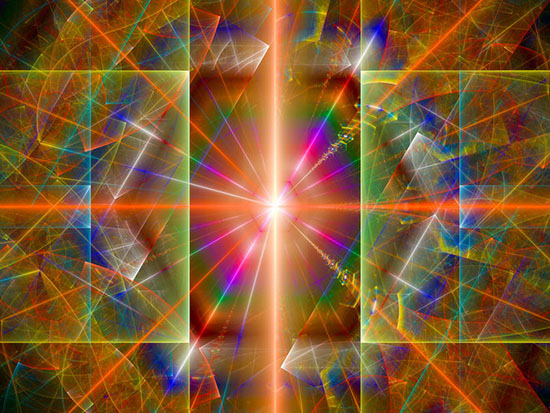
If you’ve been a science fan for the last few years, you’re aware of the exciting results to emerge from the Large Hadron Collider (LHC), which in 2012 found the Higgs boson, the subatomic particle responsible for giving mass to fundamental subatomic particles. Today, physicists have another exciting announcement to add to the Higgs saga: They have made the first unambiguous observation of Higgs bosons decaying into a matter-antimatter pair of bottom quarks. Surprisingly, the Higgs bosons decay most often in this way. The new announcement shows a strong agreement between the theoretical predictions and the experimental data, which could in turn set strict constraints on ideas of more fundamental physics that strive to explain why the Higgs boson even exists.
Mini antimatter accelerator could rival the likes of the Large Hadron Collider PhysOrg - August 10, 2018
Researchers have found a way to accelerate antimatter in a 1000x smaller space than current accelerators, boosting the science of exotic particles. The new method could be used to probe more mysteries of physics, like the properties of the Higgs boson and the nature of dark matter and dark energy, and provide more sensitive testing of aircraft and computer chips. The method has been modeled using the properties of existing lasers, with experiments planned soon. If proven, the technology could allow many more labs around the world to conduct antimatter acceleration experiments. Particle accelerators in facilities such as the Large Hadron Collider (LHC) in CERN and the Linac Coherent Light Source (LCLS) at Stanford University in the United States, speed up elementary particles like protons and electrons.
Holographic image of a black hole proposed in a graphene flake PhysOrg - July 30, 2018
The type of holographic duality illustrated by the SYK model is particularly interesting because it exhibits some of the signature properties of black holes, such as non-zero residual entropy and quantum chaos propagation. It may also help answer fundamental questions about the connection between quantum mechanics and gravity.
Black hole hologram appears in a graphene flake Physics World - July 30, 2018
'Ghost particle' found in Antarctica provides astronomy breakthrough CNN - July 12, 2018
For the first time, scientists have been able to trace the origins of a ghostly subatomic particle that traveled 3.7 billion light-years to Earth. The tiny, high-energy cosmic particle is called a neutrino, and it was found by sensors deep in the Antarctic ice in the IceCube detector. Scientists and observatories around the world were able to trace the neutrino to a galaxy with a supermassive, rapidly spinning black hole at its center, known as a "blazar". The galaxy sits to the left of Orion's shoulder in his constellation and is about 4 billion light-years from Earth. Scientists say the discovery heralds a new era of space research, allowing the use of these particles to study and observe the universe in an unprecedented way. And the finding suggests that scientists will be able to track the origin of mysterious cosmic rays for the first time.
Stephen Hawking's final paper bursts the multiverse bubble with a Holographic Universe theory - May 3, 2018
Hawking and Hertog's new theory branches off from the holographic principle, which itself is part of string theory. String theory states that each particle in the universe is actually the end point of a one-dimensional string, and the different vibration patterns of each string is what gives a particle its specific properties.
Holography, meanwhile, is the idea that the entire universe exists as a hologram, described as 3D spaces that can be mathematically reduced to a 2D projection on a surface. In their new version of the holographic principle, the authors have wrapped the fourth dimension, time, into the picture. At the beginning of time, eternal inflation can be reduced to a two-dimensional, timeless state on a spatial surface. Doing so allowed them to bypass Einstein's theory of general relativity, which breaks down in previous versions of eternal inflation. The new theory goes against Hawking's "no boundary" theory, first proposed in 1983. That stated that the universe didn't have what we could understand as a beginning, because the singularity that existed pre-Big Bang had no initial time or space boundaries.
Taming the multiverse: Stephen Hawking's final theory about the big bang Science Daily - May 3, 2018
The theory, which was submitted for publication before Hawking's death earlier this year, is based on string theory and predicts the universe is finite and far simpler than many current theories about the big bang say.
Physicists find signs of a time crystal a form of matter that 'ticks' when exposed to an electromagnetic pulse -- in the last place they expected: a crystal you might find in a child's toy Science Daily - May 3, 2018
The discovery means there are now new puzzles to solve, in terms of how time crystals form in the first place. Ordinary crystals such as salt or quartz are examples of three-dimensional, ordered spatial crystals. Their atoms are arranged in a repeating system, something scientists have known for a century. Time crystals, first identified in 2016, are different. Their atoms spin periodically, first in one direction and then in another, as a pulsating force is used to flip them. That's the "ticking." In addition, the ticking in a time crystal is locked at a particular frequency, even when the pulse flips are imperfect. Scientists say that understanding time crystals may lead to improvements in atomic clocks, gyroscopes, and magnetometers, as well as aid in building potential quantum technologies. The U.S. Department of Defense recently announced a program to fund more research into time crystal systems.
Einstein-Podolsky-Rosen paradox observed in many-particle system for the first time Science Daily - April 27, 2018
Physicists have observed the quantum mechanical Einstein-Podolsky-Rosen paradox in a system of several hundred interacting atoms for the first time. The phenomenon dates back to a famous thought experiment from 1935. It allows measurement results to be predicted precisely and could be used in new types of sensors and imaging methods for electromagnetic fields.
Quantum physicists achieve entanglement record PhysOrg - April 16, 2018
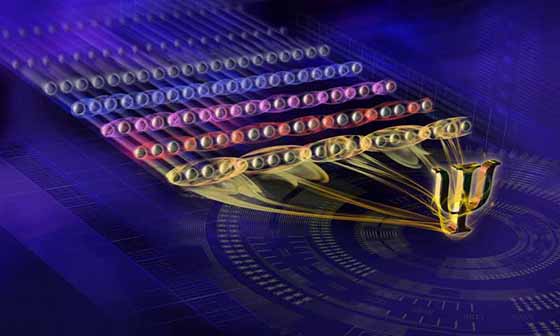
Physically, entangled particles cannot be described as individual particles with defined states, but only as a complete system. It is particularly difficult to understand entanglement when numerous particles are involved. Here, a distinction must be made between the entanglement of individual particles and genuine multi-particle entanglement. This can only be understood as a property of the overall system of all particles concerned, and cannot be explained by a combination of the subsystems being entangled.
Is Dark Matter Made Up of Mini Black Holes from the Big Bang? Live Science - April 6, 2018
Dark matter, the mysterious extra mass in the universe that emits no light yet exerts a gravitational pull, may actually be made up of primordial black holes that originated with the Big Bang. And these mini black holes can thank the Higgs boson for their birth - at least according to a new theory. This theory posits that these primeval black holes were created from instabilities in the field that gives rise to the Higgs Boson, the mysterious "God" particle discovered at the Large Hadron Collider (LHC).
A Second 'Big Bang' Could End Our Universe in an Instant, Thanks to The Higgs Boson Science Alert - April 5, 2018
Our universe may end the same way it was created: with a big, sudden bang. That's according to new research from a group of Harvard physicists, who found that the destabilization of the Higgs boson - a tiny quantum particle that gives other particles mass - could lead to an explosion of energy that would consume everything in the known universe and upend the laws of physics and chemistry.
Finding order in disorder demonstrates a new state of matter Science Daily - April 2, 2018
Physicists have identified a new state of matter whose structural order operates by rules more aligned with quantum mechanics than standard thermodynamic theory. In a classical material called artificial spin ice, which in certain phases appears disordered, the material is actually ordered, but in a "topological" form.
Massive astrophysical objects governed by subatomic equation PhysOrg - March 5, 2018
Quantum mechanics is the branch of physics governing the sometimes-strange behavior of the tiny particles that make up our universe. Equations describing the quantum world are generally confined to the subatomic realm - the mathematics relevant at very small scales is not relevant at larger scales, and vice versa. However, a surprising new discovery from a Caltech researcher suggests that the Schrodinger Equation - the fundamental equation of quantum mechanics - is remarkably useful in describing the long-term evolution of certain astronomical structures. Massive astronomical objects are frequently encircled by groups of smaller objects that revolve around them, like the planets around the sun. For example, supermassive black holes are orbited by swarms of stars, which are themselves orbited by enormous amounts of rock, ice, and other space debris. Due to gravitational forces, these huge volumes of material form into flat, round disks. These disks, made up of countless individual particles orbiting en masse, can range from the size of the solar system to many light-years across.
Physicists create new form of light Science Daily - February 15, 2018
Try a quick experiment: Take two flashlights into a dark room and shine them so that their light beams cross. Notice anything peculiar? The rather anticlimactic answer is, probably not. That's because the individual photons that make up light do not interact. Instead, they simply pass each other by, like indifferent spirits in the night.
4D World: Light Moving In Fourth Dimension Observed During Quantum Hall Experiment IBTimes - January 9, 2018
Two experiments used different methods in a two-dimensional space to simulate a four-dimensional one. In one setup, the scientists used lasers to create 2D pathways through glass and then sent lightwaves through. In another, they used crisscrossed laser beams to influence the motion of super cold atoms. With both of the systems, they were seemingly forcing the materials inside to move within another dimension, a simulated one. Although they could not physically see that dimension they were building, the scientists observed the material sent through their experiments to find evidence of the fourth-dimensional quantum Hall effect. Quantum Hall Effect
Physicists studying atomic spin surprised themselves by discovering that spinning protons bizarrely change direction when they crash into larger particles, like the nuclei of gold atoms Newsweek - January 9, 2018
Their findings may mean that the mechanisms producing particles along the direction in which the spinning proton is traveling may be very different in proton-proton collisions compared with proton-nucleus collisions. Proton-proton collisions usually produce right-skewing effects. But large nuclei, like gold, have large positive electric charges, and because of that, the electromagnetic interaction between the two colliding particles becomes a much more dynamic force than it is for two protons, which aside from being smaller also have equal charges, according to Brookhaven National Laboratory. That unequal electromagnetic charge is what causes the incoming proton to switch preference and rocket off to the left.
Four-dimensional physics in two dimensions Science Daily - January 3, 2018
For the first time, physicists have built a two-dimensional experimental system that allows them to study the physical properties of materials theorized to exist only in four-dimensional space. An international team of researchers demonstrated that the behavior of particles of light can be made to match predictions about the four-dimensional version of the 'quantum Hall effect' -- a phenomenon at the root of three Nobel Prizes in physics -- in a two-dimensional array of 'waveguides.'
Physicists say they've confirmed new form of matter in a breakthrough of 'cosmic significance' Live Science - December 9, 2017
Nearly 50 years after it was first theorized, physicists claim they’ve finally proven the existence of a new form of matter, known as ‘excitonium.’ Excitonium is made up of particles known as excitons, which are made from an escaped electron and the hole it left behind. In the new experiments, the researchers say they were able to observe the material and the precursor phase, which is said to be the ‘smoking gun’ proof of its existence.
'Angel particle' which is both matter and anti-matter is discovered after an 80-year quest in a 'landmark' breakthrough for quantum physics Daily Mail - July 21, 2017
Researchers revealed that they have found the first evidence of the elusive particles in what is being described as a 'landmark' moment in quantum physics. The discovery could help scientists to bring a quantum computing revolution, which would allow us to make machines many times more powerful than those made using existing technology.Scientists have theorized that when the Big Bang first created the universe, equal amounts of matter and anti-matter were produced. Anti-matter is made from particles which are the 'anti-particles' of those from normal matter.
Here's How Scientists Teleported the First Object Into Space Seeker - July 13, 2017
Chinese researchers successfully realized ground-to-satellite quantum teleportation using a photon particle - a feat that could one day make for a better and more secure internet. Scientists from China have just performed the first ever quantum teleportation from Earth to space. Does this mean we are now living in the future envisioned in Star Trek? Actually, no physical matter was actually “beamed up,” unfortunately - just photons. But this breakthrough might make for a better and more secure internet in the future. "Quantum teleportation brings to mind Star Trek’s transporter, where crew members are disassembled in one location to be reassembled in another. Real quantum teleportation is a much more subtle effect where information is transferred between entangled quantum states. It’s a quantum trick that could give us the ultimate in secure communication.
 Another Universe May Have Bumped Into Ours and We Might Have Proof Seeker - July 7, 2017
Another Universe May Have Bumped Into Ours and We Might Have Proof Seeker - July 7, 2017
The question isn't are we alone in the universe, it's are we alone in these universes? According to a bit of the Cosmic Microwave Background Radiation (CMB) we might have a neighbor. The CMB is the leftover light from the Big Bang itself. It's the furthest thing from us in the visible universe. It's all around us constantly, but it's super low-energy, because, again, it's been around since the beginning of the universe. Over time, we've taken the CMB's temperature, mapped it in increasing detail and in doing so we found something curious.
Physicists create 'negative mass' Science Daily - April 17, 2017
Physicists have created a fluid with negative mass, which is exactly what it sounds like. Push it, and unlike every physical object in the world we know, it doesn't accelerate in the direction it was pushed. It accelerates backwards. The phenomenon is rarely created in laboratory conditions and can be used to explore some of the more challenging concepts of the cosmos. Hypothetically, matter can have negative mass in the same sense that an electric charge can be either negative or positive. People rarely think in these terms, and our everyday world sees only the positive aspects of Isaac Newton's Second Law of Motion, in which a force is equal to the mass of an object times its acceleration, or F=ma. In other words, if you push an object, it will accelerate in the direction you're pushing it. Mass will accelerate in the direction of the force.
'Blurred times' in a quantum world PhysOrg - March 9, 2017
When measuring time, we normally assume that clocks do not affect space and time, and that time can be measured with infinite accuracy at nearby points in space. However, combining quantum mechanics and Einstein's theory of general relativity theoretical physicists from the University of Vienna and the Austrian Academy of Sciences have demonstrated a fundamental limitation for our ability to measure time. The more precise a given clock is, the more it "blurs" the flow of time measured by neighboring clocks. As a consequence, the time shown by the clocks is no longer well defined.
How disturbances interact with a dynamic space-time fabric: 'Field patterns' as a new mathematical object Science Daily - February 15, 2017
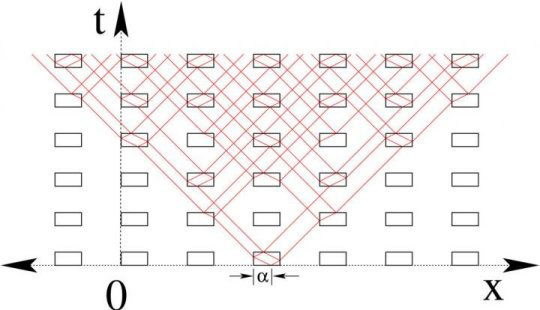
Mathematicians propose a theoretical framework to understand how waves and other disturbances move through materials in conditions that vary in both space and time. The theory is called 'field patterns' - characteristic patterns of how disturbances react to changing conditions. Because field patterns exhibit characteristics of both propagating waves and localized particles, field pattern theory may answer some of the questions posed by quantum mechanics, in which objects can be treated as both particles and waves.
Physicists demonstrate existence of new subatomic structure once thought unlikely to exist PhysOrg - November 4, 2016
Researchers used sophisticated supercomputer simulations to show the quasi-stable existence of a tetraneutron, a structure comprised of four neutrons (subatomic particles with no charge).
New Particle May Hide in Old Atom-Smasher Data Live Science - October 28, 2016
A study of some old data from a 1990s-era particle-accelerator experiment could be a hint at new physics. Or it could be a fluke. From 1989 to 2000, the European Organization for Nuclear Research (CERN) operated an atom smasher called the Large Electron-Positron Collider (LEP), in which particles were sent crashing into one another at near light speed. Arno Heister, a scientist at CERN, on his own time, decided to look at some data produced between 1992 and 1995 in one of the detectors in the LEP, called ALEPH. These detectors record what happens during those high-speed collisions, when energy - sometimes in the form of exotic particles - comes spewing out. Although not as powerful as the Large Hadron Collider (LHC) atom smasher that's in use today, the LEP made some important discoveries, such as finding the mass of the W boson, the particle that carries the weak nuclear force. LEP was dismantled in 2000 to make way for the LHC.
Ripples in fabric of space-time? Hundreds of undiscovered black holes Science Daily - September 7, 2016
Computer simulations of a spherical collection of stars known as 'NGC 6101' reveal that it contains hundreds of black holes, until now thought impossible. Recent observations already found black hole candidates in similar systems, with this research enabling astrophysicists to map black holes in other clusters. These systems could be the cradle of gravitational wave emission, 'ripples' in the fabric of space-time.
Physicists confirm possible discovery of fifth force of nature PhysOrg - August 15, 2016
Recent findings indicating the possible discovery of a previously unknown subatomic particle may be evidence of a fifth fundamental force of nature. For decades, we've known of four fundamental forces: gravitation, electromagnetism, and the strong and weak nuclear forces. If confirmed by further experiments, this discovery of a possible fifth force would completely change our understanding of the universe, with consequences for the unification of forces and dark matter.
New state of matter detected in a two-dimensional material Science Daily - April 4, 2016
An international team of researchers has found evidence of a mysterious new state of matter, first predicted 40 years ago, in a real material. This state, known as a quantum spin liquid, causes electrons -- thought to be indivisible building blocks of nature -- to break into pieces. The researchers, including physicists from the University of Cambridge, measured the first signatures of these fractional particles, known as Majorana fermions, in a two-dimensional material with a structure similar to graphene. Their experimental results successfully matched with one of the main theoretical models for a quantum spin liquid, known as a Kitaev model. The results are reported in the journal Nature Materials. Quantum spin liquids are mysterious states of matter which are thought to be hiding in certain magnetic materials, but had not been conclusively sighted in nature.
The world's newest atom-smasher achieves its 'first turns' PhysOrg - March 2, 2016
One of the world's top particle accelerators has reached a milestone, achieving its "first turns" - circulating beams of particles for the first time - and opening a new window into the universe, a view that will give physicists access to a record rate of particle collisions in a tiny volume in space. Japan's SuperKEKB accelerator fills a unique role in the pantheon of atom smashers worldwide. It's at the forefront of what physicists call the "intensity frontier," designed to deliver more than 40 times the rate of collisions between particles than its predecessor. Studying the particles produced in these collisions will give physicists a clearer view of the fundamental building blocks of the universe and provide new opportunities to explore physics that goes beyond today's standard model of particle physics.
Tracking the transition of early-universe quark soup to matter as we know it PhysOrg - April 7, 2014
Forget Schrodinger's cat, can you understand the quantum pigeonhole principle puzzle? Telegraph - January 20, 2016
Solve this riddle: how do you put three pigeons into two pigeonholes, with no two pigeons ending up in the same hole? Physicists at the university claim they've found a way to solve the puzzle.
They've argued particles on opposite ends of the universe can be connected, without any previous interaction. The phenomenon suggests there is a new type of quantum reality that impacts all matter. This is an effect similar to something known as entanglement. In quantum physics, entangled particles remain connected so that actions performed by one affects the behavior of the other, even if they are separated by huge distances. But in the new theory, cosmic particles don't need a previous connection to have taken place.
Can three pigeons be in two pigeonholes with no two pigeons in the same hole? PhysOrg - January 20, 2016
Research published this month in the Proceedings of the National Academy of Sciences (PNAS) introduced a new quantum phenomenon which the authors called the "quantum pigeonhole principle." Prior to this breakthrough, the pigeonhole principle was a basic tenet of conventional wisdom. It states that if you put three pigeons in two pigeonholes then at least two of the pigeons must end up in the same hole. It is an obvious yet fundamental principle of nature as it captures the very essence of counting. The research violates this principle. The study demonstrates how to put an arbitrarily large number of particles in two boxes without any two particles ending up in the same box.
SLAC theorist explains quantum gravity PhysOrg - November 19, 2015
Physicists have quantum theories for the last three of them that allow very precise calculations of phenomena on the smallest, subatomic scales. However, gravity does not fit into this scheme. Despite decades of research, there is no generally accepted quantum theory of gravity, which is needed to better understand fundamental aspects of our universe.
 Scientist May Have Discovered Alternate Universes Huffington Post - November 4, 2015
Scientist May Have Discovered Alternate Universes Huffington Post - November 4, 2015
Alternate or parallel universes may actually exist, according to the findings of one astrophysicist, but many in the scientific community aren't convinced. Ranga-Ram Chary, U.S. Planck Data Center's project manager in California, recently discovered a "mysterious glow" by mapping the Cosmic Microwave Background, otherwise known as the light that was left over from a few hundred thousand years after the Big Bang.
Large Hadron Collider discovers new pentaquark particle BBC - July 14, 2015
It was first predicted to exist in the 1960s but, much like the Higgs boson particle before it, the pentaquark eluded science for decades until its detection at the LHC. The discovery, which amounts to a new form of matter, was made by the Hadron Collider's LHCb experiment.
New method of quantum entanglement vastly increases how much information can be carried in a photon PhysOrg - June 30, 2015
A team of researchers has demonstrated a new way to harness light particles, or photons, that are connected to each other and act in unison no matter how far apart they are - a phenomenon known as quantum entanglement. In previous studies, photons have typically been entangled by one dimension of their quantum properties - usually the direction of their polarization. In the new study, researchers demonstrated that they could slice up and entangle each photon pair into multiple dimensions using quantum properties such as the photons' energy and spin. This method, called hyperentanglement, allows each photon pair to carry much more data than was possible with previous methods.
Einstein saves the quantum cat PhysOrg - June 19, 2015
Einstein's theory of time and space will celebrate its 100th anniversary this year. Even today it captures the imagination of scientists. Researchers have now discovered that this world-famous theory can explain yet another puzzling phenomenon: the transition from quantum behavior to our classical, everyday world. In 1915 Albert Einstein formulated the theory of general relativity which fundamentally changed our understanding of gravity. He explained gravity as the manifestation of the curvature of space and time. Einstein's theory predicts that the flow of time is altered by mass. This effect, known as "gravitational time dilation", causes time to be slowed down near a massive object. It affects everything and everybody; in fact, people working on the ground floor will age slower than their colleagues a floor above, by about 10 nanoseconds in one year.
Quantum Cheshire Cat effect may be explained by standard quantum mechanics PhysOrg - June 13, 2015
"A grin without a cat" is how Lewis Carroll describes the Cheshire Cat's mysterious way of disappearing while leaving its grin behind in his 1865 classic, Alice in Wonderland. The fanciful character raises a question that has captured physicists' attention over the past few years: can an object be separated from its properties? However, in a new paper published in the New Journal of Physics has questioned this interpretation of the results. Instead of a particle being separated from its properties, they suggest that the results can be explained by a standard quantum effect, quantum interference, in which an individual particle interferes with itself due to its wave-like properties.
Strange behavior of quantum particles may indicate the existence of other parallel universes PhysOrg - June 3, 2015
Quantum mechanics is a strange realm of reality. Particles at this atomic and subatomic level can appear to be in two places at once. Because the activity of these particles is so iffy, scientists can only describe what's happening mathematically by "drawing" the tiny landscape as a wave of probability.
Quantum experiment verifies Einstein's 'spooky action at a distance' Science Daily - March 24, 2015
An experiment devised in Griffith University's Centre for Quantum Dynamics has for the first time demonstrated Albert Einstein's original conception of "spooky action at a distance" using a single particle. According to quantum mechanics, a single particle can be described by a wave function that spreads over arbitrarily large distances, but is never detected in two or more places. This phenomenon is explained in quantum theory by what Einstein disparaged in 1927 as "spooky action at a distance," or the instantaneous non-local collapse of the wave function to wherever the particle is detected. Almost 90 years later, by splitting a single photon between two laboratories, scientists have used homodyne detectors -- which measure wave-like properties -- to show the collapse of the wave function is a real effect. This phenomenon is the strongest yet proof of the entanglement of a single particle, an unusual form of quantum entanglement that is being increasingly explored for quantum communication and computation.
General Relativity at 100: Einstein's Famous Theory Has Aged Well BBC - March 5, 2015
Albert Einstein's theory of general relativity has held up pretty well after a century out in the world. The famous theory, which Einstein published in 1915, remains the bedrock upon which scientists' understanding of the origin and evolution of the universe rests. It continues to inspire research into some of the most fundamental unanswered questions in physics and astronomy. General relativity "is now, I think, routinely accepted as the foundation of our description of the universe at large, which we call cosmology; of black holes, of neutron stars and of small corrections to the orbits of planets and spacecraft in our own solar system," said Roger Blandford of the Kavli Institute for Particle Astrophysics and Cosmology at Stanford University.
The first ever photograph of light as both a particle and wave PhysOrg - March 2, 2015
Light behaves both as a particle and as a wave. Since the days of Einstein, scientists have been trying to directly observe both of these aspects of light at the same time. Now, scientists at EPFL have succeeded in capturing the first-ever snapshot of this dual behavior. Quantum mechanics tells us that light can behave simultaneously as a particle or a wave. However, there has never been an experiment able to capture both natures of light at the same time; the closest we have come is seeing either wave or particle, but always at different times. Taking a radically different experimental approach, EPFL scientists have now been able to take the first ever snapshot of light behaving both as a wave and as a particle.
Physicists offer a solution to the puzzle of the origin of matter in the universe Science Daily - February 26, 2015
Most of the laws of nature treat particles and antiparticles equally, but stars and planets are made of particles, or matter, and not antiparticles, or antimatter. That asymmetry, which favors matter to a very small degree, has puzzled scientists for many years. Physicists offer a possible solution to the mystery of the origin of matter in the universe. Most of the laws of nature treat particles and antiparticles equally, but stars and planets are made of particles, or matter, and not antiparticles, or antimatter. That asymmetry, which favors matter to a very small degree, has puzzled scientists for many years.
Quantum Experiment Helps Prove Einstein's Theory of Relativity Live Science - January 30, 2015
Building a quantum computer can sometimes yield unexpected benefits - like providing the right environment to demonstrate that Albert Einstein's theory of special relativity is, in fact, correct.
Using atoms in certain quantum states, researchers at the University of California, Berkeley, were able to show that space does not appear squeezed in one direction compared to another, as it would if relativity were not correct. Rather, space looks the same from any direction, as relativity predicts. The experiment used partially entangled atoms that were a byproduct of an attempt to build quantum computers. Special relativity is a cornerstone of modern physics, and was formulated by Einstein in 1905. The theory states two things: the laws of physics are the same everywhere, and the speed of light is a constant, provided that you're not accelerating when you're measuring such phenomena. It can be used to explain the behavior of objects in space and time. (It's companion, the general relativity includes the effects of gravity and acceleration).
Does time pass? New book says it does - but not in the way you may think PhysOrg - January 28, 2015
Time should be regarded as a dimension of spacetime, as relativity theory holds - so it does not pass by us in some way, because spacetime doesn't. Instead, time is part of the uniform larger fabric of the universe, not something moving around inside it. Events do not sail past us and vanish forever; they just exist in different parts of spacetime. Skow is more impressed by an alternative idea called the "moving spotlight" theory, which may allow that the past and future exist on a par with the present. However, the theory holds, only one moment at a time is absolutely present, and that moment keeps changing, as if a spotlight were moving over it. This is also consistent with relativity, Skow thinks - but it still treats the present as being too distinct, as if the present were cut from different cloth than the rest of the universal fabric.
 Scientists slow the speed of light BBC - January 25, 2015
Scientists slow the speed of light BBC - January 25, 2015
They sent photons - individual particles of light - through a special mask. It changed the photons' shape - and slowed them to less than light speed. The photons remained travelling at the lower speed even when they returned to free space.
See it, touch it, feel it: Researchers use ultrasound to make invisible 3-D haptic shape that can be seen and felt Science Daily - December 3, 2014
Technology has changed rapidly over the last few years with touch feedback, known as haptics, being used in entertainment, rehabilitation and even surgical training. New research, using ultrasound, has developed an invisible 3-D haptic shape that can be seen and felt.
The invisibility cloak for TIME: Experts create a cloaking device capable of hiding entire events in 'bubbles' Daily Mail - December 2, 2014
The quest for a true invisibility cloak, seen in films such as Harry Potter, is the holy grail for physicists. But while many have been able to briefly conceal objects from view, and even shield sounds, one team has developed a way to cloak entire events. By concealing these events behind strands of laser light, the researchers could make it appear as if a moment - such as an object moving from one position to another - had spontaneously occurred of travelled inside a 'bubble of time.'
Scientists propose existence and interaction of parallel worlds: Many Interacting Worlds theory challenges foundations of quantum science Science Daily - October 30, 2014
Academics are challenging the foundations of quantum science with a radical new theory on parallel universes. Scientists now propose that parallel universes really exist, and that they interact. They show that such an interaction could explain everything that is bizarre about quantum mechanics.
Elusive particle that is its own antiparticle observed Science Daily - October 3, 2014
Scientists have observed an exotic particle that behaves simultaneously like matter and antimatter, a feat of math and engineering that could yield powerful computers based on quantum mechanics.
'Quantum Cheshire Cat' becomes reality BBC - July 29, 2014
Scientists have for the first time separated a particle from one of its physical properties - creating a "quantum Cheshire Cat". The phenomenon is named after the curious feline in Alice in Wonderland, who vanishes leaving only its grin. Researchers took a beam of neutrons and separated them from their magnetic moment, like passengers and their baggage at airport security.
If Spacetime Were a Superfluid, Would It Unify Physics - or Is the Theory All Wet? Scientific American - June 19, 2014
If spacetime is like a liquid - a concept some physicists say could help resolve a confounding disagreement between two dominant theories in physics - it must be a very special liquid indeed. A recent study compared astrophysical observations with predictions based on the notion of fluid spacetime, and found the idea only works if spacetime is incredibly smooth and freely flowing - in other words, a superfluid. Thinking of spacetime as a liquid may be a helpful analogy. Physicists have been considering this possibility since the 1990s in an attempt to reconcile the dominant theory of gravity on a large scale - general relativity - with the theory governing the very smallest bits of the universe - quantum mechanics.
'Big G': Scientists Pin Down Elusive Gravitational Constant Live Science - June 19, 2014
>
A fundamental constant that sets the size of the gravitational force between all objects has finally been pinned down using the quirky quantum behavior of tiny atoms. The new results could help set the official value of the gravitational constant, and may even help scientists find evidence of extra space-time dimensions. According to legend, Sir Isaac Newton first formulated his theory of gravity after watching a falling apple. In Newton's equations, the force of gravity grows with the mass of two objects in question, and the force gets weaker the more distant the objects are from each other. The English polymath knew the objects' masses had to be multiplied by a constant, or "big G," in order to arrive at the gravitational force between those two objects, but he wasn't able to calculate its value. ("Big G" is different from "little g," which is the local gravitational acceleration on Earth.)
Scientists discover how to turn light into matter after 80-year quest Science Daily - May 19, 2014
Physicists have discovered how to create matter from light -- a feat thought impossible when the idea was first theorized 80 years ago. In just one day over several cups of coffee in a tiny office, three physicists worked out a relatively simple way to physically prove a theory first devised by scientists Breit and Wheeler in 1934. Breit and Wheeler suggested that it should be possible to turn light into matter by smashing together only two particles of light (photons), to create an electron and a positron -- the simplest method of turning light into matter ever predicted. The calculation was found to be theoretically sound, but Breit and Wheeler said that they never expected anybody to physically demonstrate their prediction.
Tracking the transition of early-universe quark soup to matter-as-we-know-it Science Daily - April 7, 2014
Ever wonder how the hot soup of subatomic particles that filled the early universe transformed into the ordinary matter of today's world? Nuclear physicists exploring this question can't exactly travel back 13.8 billion years to watch what really happened, but they can recreate matter at the extreme temperatures and densities that existed just after the Big Bang by smashing together ordinary atomic nuclei at the Relativistic Heavy Ion Collider (RHIC).
Ever wonder how the hot soup of subatomic particles that filled the early universe transformed into the ordinary matter of today's world? Nuclear physicists exploring this question can't exactly travel back 13.8 billion years to watch what really happened, but they can recreate matter at the extreme temperatures and densities that existed just after the Big Bang by smashing together ordinary atomic nuclei at the Relativistic Heavy Ion Collider (RHIC).
An analysis of Einstein's 1931 paper featuring a dynamic model of the universe PhysOrg - February 19, 2014
A paper published in the European Physical Journal H provides the first English translation and an analysis of one of Albert Einstein's little-known papers, "On the cosmological problem of the general theory of relativity." Published in 1931, it features a forgotten model of the universe, while refuting Einstein's own earlier static model of 1917. In this paper, Einstein introduces a cosmic model in which the universe undergoes an expansion followed by a contraction. This interpretation contrasts with the monotonically expanding universe of the widely known Einstein-de Sitter model of 1932.
Closing the 'free will' loophole: Using distant quasars to test Bell's theorem Science Daily - February 20, 2014
Astronomers propose an experiment that may close the last major loophole of Bell's inequality -- a 50-year-old theorem that, if violated by experiments, would mean that our universe is based not on the textbook laws of classical physics, but on the less-tangible probabilities of quantum mechanics. Such a quantum view would allow for seemingly counterintuitive phenomena such as entanglement, in which the measurement of one particle instantly affects another, even if those entangled particles are at opposite ends of the universe. Among other things, entanglement -- a quantum feature Albert Einstein skeptically referred to as "spooky action at a distance" -- seems to suggest that entangled particles can affect each other instantly, faster than the speed of light.
Natural 3-D Counterpart to Graphene Discovered: New Form of Quantum Matter Science Daily - January 17, 2014
A collaboration of researchers at the U.S Department of Energy has discovered that sodium bismuthate can exist as a form of quantum matter called a three-dimensional topological Dirac semi-metal (3DTDS). This is the first experimental confirmation of 3D Dirac fermions in the interior or bulk of a material, a novel state that was only recently proposed by theorists. Paul Dirac English theoretical physicist
How Light Can Be Both a Particle and a Wave Scientific American - December 13, 2013
You may have heard that light consists of particles called photons. How could something as simple as light be made of particles? Physicists describe light as both a particle and a wave. In fact, light's wavelike behavior is responsible for a lot of its cool effects, such as the iridescent colors produced on the surface of bubbles. To see a dramatic and mind-bending example of how light behaves like a wave, all you need is three pieces of mechanical pencil lead, a laser pointer and a dark room.
Scientists Discover a Jewel at the Heart of Quantum Physics Wired - December 12, 2013
Physicists reported this week the discovery of a jewel-like geometric object that dramatically simplifies calculations of particle interactions and challenges the notion that space and time are fundamental components of reality. The revelation that particle interactions, the most basic events in nature, may be consequences of geometry significantly advances a decades-long effort to reformulate quantum field theory, the body of laws describing elementary particles and their interactions. Interactions that were previously calculated with mathematical formulas thousands of terms long can now be described by computing the volume of the corresponding jewel-like 'amplituhedron,' which yields an equivalent one-term expression. The new geometric version of quantum field theory could also facilitate the search for a theory of quantum gravity that would seamlessly connect the large- and small-scale pictures of the universe. Attempts thus far to incorporate gravity into the laws of physics at the quantum scale have run up against nonsensical infinities and deep paradoxes. The amplituhedron, or a similar geometric object, could help by removing two deeply rooted principles of physics: locality and unitarity.
In a "Rainbow" Universe Time May Have No Beginning Scientific American - December 9, 2013
What if the universe had no beginning, and time stretched back infinitely without a big bang to start things off? That's one possible consequence of an idea called "rainbow gravity," so-named because it posits that gravity's effects on space-time are felt differently by different wavelengths of light, aka different colors in the rainbow. Rainbow gravity was first proposed 10 years ago as a possible step toward repairing the rifts between the theories of general relativity (covering the very big) and quantum mechanics (concerning the realm of the very small). The idea is not a complete theory for describing quantum effects on gravity, and is not widely accepted. Nevertheless, physicists have now applied the concept to the question of how the universe began, and found that if rainbow gravity is correct, space-time may have a drastically different origin story than the widely accepted picture of the big bang. According to Einstein's general relativity, massive objects warp space-time so that anything traveling through it, including light, takes a curving path.
Search Escalates for Key to Why Matter Exists Scientific American - October 23, 2013
Physicists have completed a new round of searches for the answer to why matter dominates antimatter. But the radioactive decay that would solve the puzzle evades them
Seeing Light in a New Light: Scientists Create Never-Before-Seen Form of Matter Science Daily - September 26, 2013
Researchers have managed to coax photons into binding together to form molecules -- a state of matter that, until recently, had been purely theoretical.
Space-Time Is Not the Same for Everyone Science Daily - July 9, 2013
Before the Big Bang, space-time as we know it did not exist. So how was it born? The process of creating normal space-time from an earlier state dominated by quantum gravity has been studied for years by theorists at the Faculty of Physics, University of Warsaw. Recent analyses suggest a surprising conclusion: not all elementary particles are subject to the same space-time. Several billion years ago, in the era soon after the Big Bang, the Universe was so dense and so hot that elementary particles felt the existence of gravity strongly. For decades, physicists around the world have been attempting to discover the laws of quantum gravity describing this phase of the evolution of the Universe.
 'Twisted light' idea makes for terabit rates in fibre BBC - June 28, 2013
'Twisted light' idea makes for terabit rates in fibre BBC - June 28, 2013
A novel way of boosting data rates in optical communication using "twisted light" has been shown to work in optical fibres. The light is effectively corkscrew-shaped, and more data can be encoded in differently twisted beams. The concept had been shown off over "free space" but it remained unclear if it would work in fibres. Now a team reporting in Science has demonstrated data rates of 1.6 terabits per second over 1km of optical fibre.
Milestone for Quantum Networks: First Entanglement Between Light and an Optical Atomic Coherence Science Daily - June 19, 2013
Using clouds of ultra-cold atoms and a pair of lasers operating at optical wavelengths, researchers have reached a quantum network milestone: entangling light with an optical atomic coherence composed of interacting atoms in two different states. The development could help pave the way for functional, multi-node quantum networks.
New 'Charmed' Particle Represents Rare State of Matter Live Science - June 19, 2013
A new type of particle may have shown up independently at two particle accelerators, physicists say. The particle, made of four quarks (the ingredients of protons and neutrons), appears to represent a state of matter previously unknown. Signs of the particle were sighted at the Belle experiment in Japan and the Beijing Spectrometer Experiment (BESIII) in China. Scientists can't be sure what the particle is made of, or if it's even a single particle at all - there's a chance it could be two particles, each made of a pair of quarks, bound together. But nothing like it has been seen before, and the discovery offers the hope of clarifying the strange nature of quarks.
Einstein's theory of relatively seen in action by astronomers Telegraph.co.uk - April 26, 2013
Astronomers measured bursts of energy from a neutron star which is being orbited by a smaller white dwarf star. The gravity created by the neutron star, which is a super dense spinning pulsar, created a wrinkle in the fabric of space time in a way predicted by Einstein in his famous theory in 1915. The neutron star, which is just 12 miles across but weights twice as much as our own sun, has gravity that is 300 billion times stronger than that felt on the surface of Earth. At the centre of this star, a billion tonnes of matter would be squeezed into an areas the size of a sugar cube. This enormous gravitational force should create a distortion in space-time according to Einstein's theory. As the white dwarf – a glowing remnant of another dead star – orbits the neutron star they should create wrinkles that move out in space time known as gravitational waves.
Einstein's Theory of Relativity Victorious Once Again Live Science - April 25, 2013
In a match-up between quantum theory and the general theory of relativity, Einstein's theory has once again come out victorious: this time in an orbiting pair of ultra-dense stars. The star pair, about 7,000 light-years from Earth provides a unique opportunity to test the boundary between two theories of physics, according to SPACE.com. Though Albert Einstein's theory of relativity beautifully predicts how the gravity of massive objects curves space-time, it isn't complete: it can't explain the weird behavior of the ultra-small world, which is described by quantum mechanics.
Particle Physics Research Sheds New Light On Possible 'Fifth Force of Nature' Science Daily - February 22, 2013
In a breakthrough for the field of particle physics, Professor of Physics Larry Hunter and colleagues at Amherst College and The University of Texas at Austin have established new limits on what scientists call "long-range spin-spin interactions" between atomic particles. These interactions have been proposed by theoretical physicists but have not yet been seen. Their observation would constitute the discovery of a "fifth force of nature" (in addition to the four known fundamental forces: gravity, weak, strong and electromagnetic) and would suggest the existence of new particles, beyond those presently described by the Standard Model of particle physics.
You don't exist in an infinite number of places, say scientists PhysOrg - January 25, 2013
If you've read about how modern cosmology may imply that, in an infinite universe, the existence of planets and the life forms that live on them must be repeated an infinite number of times, you may have been just a little bit skeptical. So are a couple scientists from Spain, who have posted a paper at arXiv.org criticizing the concept of the infinite repetition of histories in space, an idea closely related to the concepts of "alternate histories," "parallel universes," and the "many worlds interpretation," among others. The basic idea of the infinite repetition of histories in space is that, if you take yourself right now and change one thing (say make your red shirt a blue one), then there's another you somewhere who is exactly the same except for that one difference.
Extending Einstein's Ideas: New Kind of Quantum Entanglement Demonstrated PhysOrg - December 16, 2012
Physicists at the University of Calgary and at the Institute for Quantum Computing in Waterloo have published new research in Nature Physics which builds on the original ideas of Einstein and adds a new ingredient: a third entangled particle. Quantum entanglement is one of the central principles of quantum physics, which is the science of sub-atomic particles. Multiple particles, such as photons, are connected with each other even when they are very far apart and what happens to one particle can have an effect on the other one at the same moment, even though these effects can not be used to send information faster than light. The new form of three-particle entanglement demonstrated in this experiment, which is based on the position and momentum properties of photons, may prove to be a valuable part of future communications networks that operate on the rules of quantum mechanics, and could lead to new fundamental tests of quantum theory that deepen our understanding of the world around us.